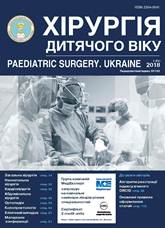Ct-diagnosis of anomalous origin of one of the pulmonary artery branches from the aorta (hemitruncus)
DOI:
https://doi.org/10.15574/PS.2018.59.36Keywords:
hemitruncus arteriosus, multidetector computed tomography, congenital heart defectsAbstract
The anomalous origin of a pulmonary artery branch from the aorta (AOPA), or hemitruncus arteriosus, is a rare congenital cardiac anomaly characterized by the anomalous origin of one of the pulmonary arteries (PA) branches from the ascending aorta and a normal origin of the other PA branch from the right ventricular outflow tract (RVOT).Objective: to demonstrate the potential of multidetector computed tomography (MDCT) in evaluation of the cardiovascular anatomy of hemitruncus and the concomitant pathology for the planning of surgical treatment of patients.
Material and methods. Between January 2007 and November 2017, in 9 consecutive patients (age range from 2 days to 2 weeks) with hemitruncus arteriosus after previous transthoracic echocardiography (TTE), a non-cardiac-gated, contrast-enhanced multidetector CT (MDCT) was performed, using a 16-slice computer tomograph.
Results. Among 9 patients with hemitruncus arteriosus, only one patient had a distal origin of the right PA from the ascending aorta, all others had proximal origin of the right PA. All patients had concomitant congenital malformations of the cardiovascular system, such as: patent ductus arteriosus (n=9), atrial septal defect (n=1), and aortic arch anomalies including aortic coarctation, aortic arch isthmus hypoplasia (n=2), and vascular rings (n=2). One patient with proximal origin of the right PA was examined after the total surgical correction.
Conclusions. Multidetector computed tomography is a valuable method to evaluate cardiovascular anatomy, lung parenchyma, airways and mediastinum in patients with hemitruncus arteriosus. 3D Reconstructed images are particularly useful for improving the detection of abnormalities, providing accurate measurement of length and volumes for clarification of complex spatial relationship between anomalous mediastinal vessels and adjacent intrathoracic structures.
References
Fontana GP, Spach MS, Effmann EL, Sabiston Jr DC. (1987). Origin of the right pulmonary artery from the ascending aorta. Ann Surg. 206(1): 102–13. https://doi.org/10.1097/00000658-198707000-00016; PMid:3606229 PMCid:PMC1492932
Kirkpatrick SE, Girod DA, King H. (1967). Aortic origin of the right pulmo- nary artery. Surgical repair without a graft. Circulation. 36: 777-82. https://doi.org/10.1161/01.CIR.36.5.777; PMid:6050933
Kutsche LM, Van Mierop LH. (1988). Anomalous origin of a pulmonary artery from the ascending aorta: associated anomalies and pathogenesis. Am J Cardiol. 61(10): 850-6. https://doi.org/10.1016/0002-9149(88)91078-8
Liu H, Juan Y.H, Chen J, Xie Z et al. (2015). Anomalous Origin of One Pulmonary Artery Branch From the Aorta: Role of MDCT Angiography. AJR. 204: 979-987. https://doi.org/10.2214/AJR.14.12730; PMid:25905931
Nathan M, Rimmer D, Piercey G, Del Nido PJ, Mayer JE, Bacha EA et al. (2007). Early repair of hemitruncus: excellent early and late outcomes. J Thorac Cardiovasc Surg. 133: 1329-35. https://doi.org/10.1016/j.jtcvs.2006.12.041; PMid:17467452
Pankaj G, Sachin T, Shyam S, Anita S, Rajnish J, Shiv K et al. (2012). The anomalous origin of one pulmonary artery branch from the aorta. Interact Cardio VascThorac Surg. 15: 86-92. https://doi.org/10.1093/icvts/ivs110; PMid:22467006 PMCid:PMC3380986
Stanton RE, Durnin RE, Fyler DC, Lindesmith GG, Meyer BW. (1968). Right pulmonary artery originating from ascending aorta. Am J Dis Child. 115: 403-13. https://doi.org/10.1001/archpedi.1968.02100010405001
Xie L, Gao L, Wu Q, et al. (2015). Anomalous origin of the right pulmonary artery from the ascending aorta: results of direct implantation surgical repair in 6 infants. Journal of Cardiothoracic Surgery. 10: 97. https://doi.org/10.1186/s13019-015-0307-9; PMid:26162911
Downloads
Issue
Section
License
The policy of the Journal “PAEDIATRIC SURGERY. UKRAINE” is compatible with the vast majority of funders' of open access and self-archiving policies. The journal provides immediate open access route being convinced that everyone – not only scientists - can benefit from research results, and publishes articles exclusively under open access distribution, with a Creative Commons Attribution-Noncommercial 4.0 international license(СС BY-NC).
Authors transfer the copyright to the Journal “PAEDIATRIC SURGERY.UKRAINE” when the manuscript is accepted for publication. Authors declare that this manuscript has not been published nor is under simultaneous consideration for publication elsewhere. After publication, the articles become freely available on-line to the public.
Readers have the right to use, distribute, and reproduce articles in any medium, provided the articles and the journal are properly cited.
The use of published materials for commercial purposes is strongly prohibited.

